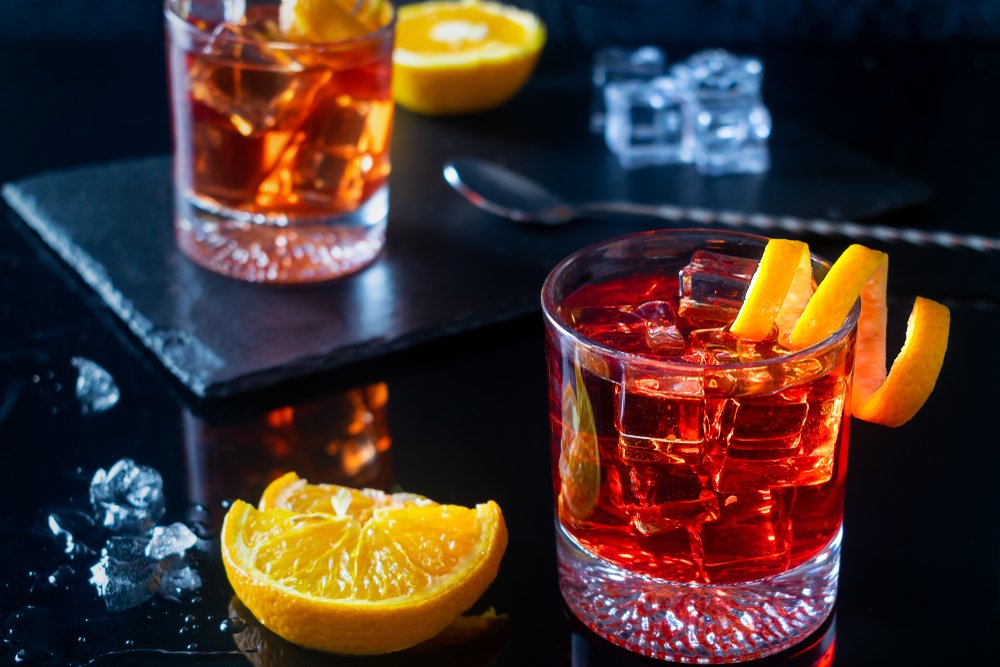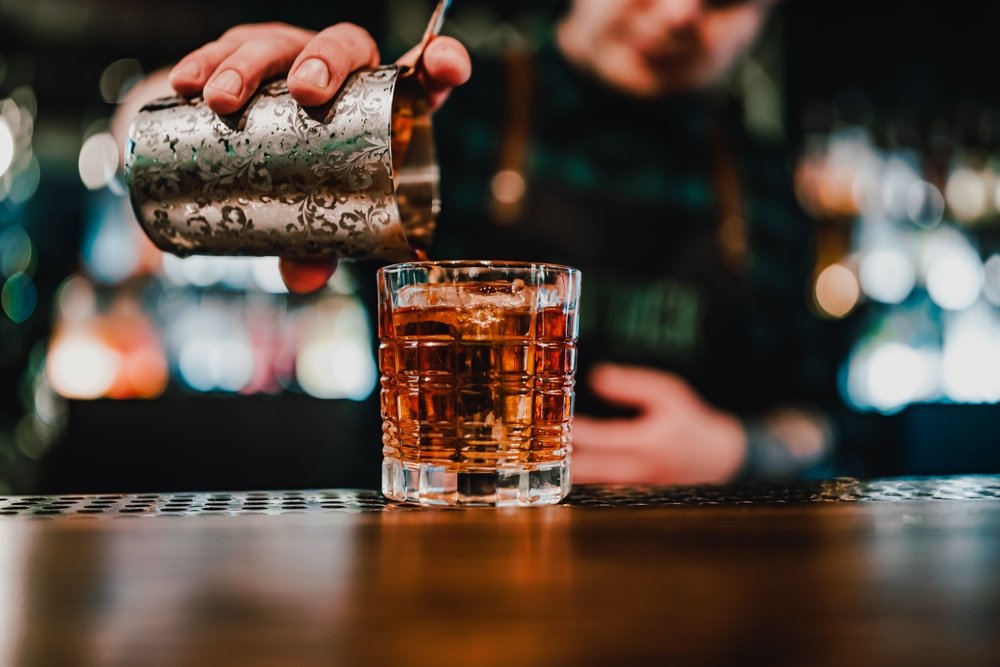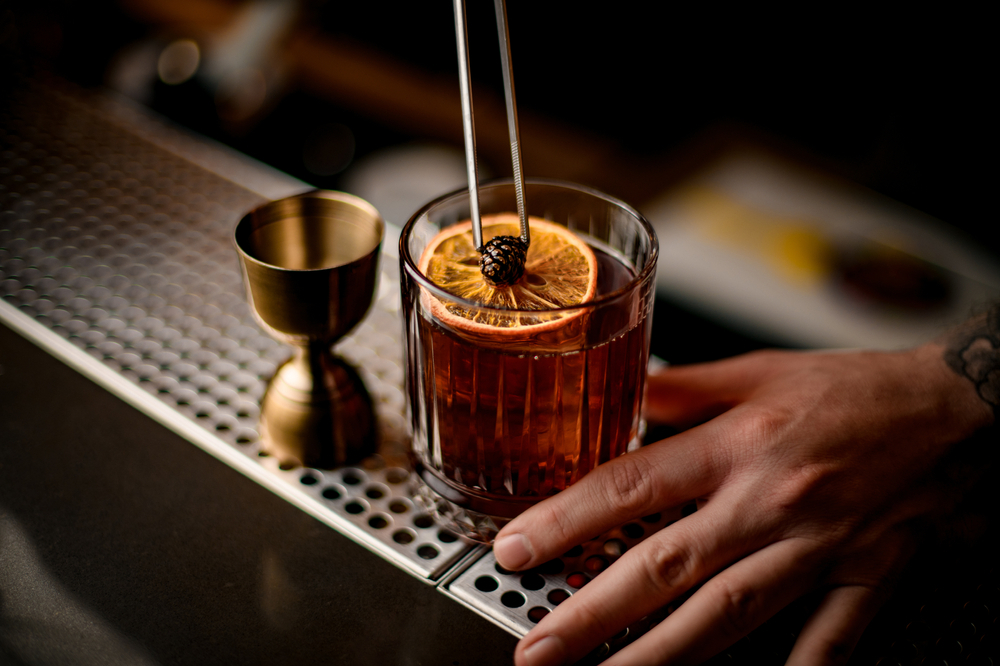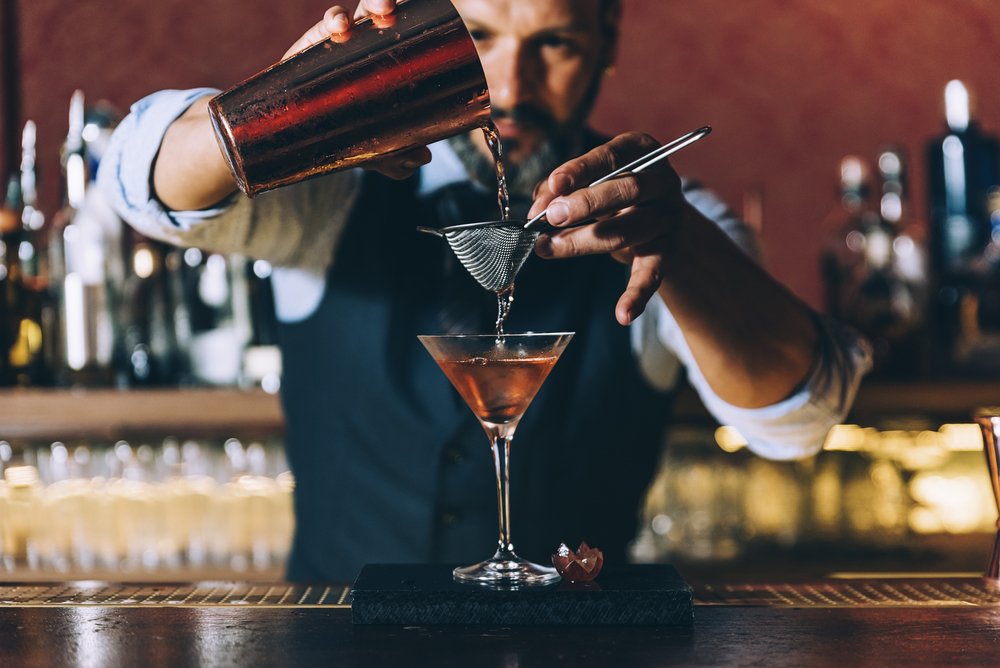The Negroni Cocktail is an iconic Italian cocktail believed to have originated in Florence around 1919. Legend has it that Count Camillo Negroni requested his favorite cocktail, the Americano, to be strengthened, which led the bartender to replace the soda water with gin. The result was a beautifully balanced blend of bitter and sweet, making it a perfect aperitif.
Ingredients:
- 30 ml (1 oz) gin
- 30 ml (1 oz) sweet red vermouth
- 30 ml (1 oz) Campari
- Orange slice or orange twist for garnish
- Ice
Instructions:
- Glass Preparation: Use a short glass, often referred to as an Old Fashioned glass. You can chill it by placing it in the freezer or by filling it with ice and water while you gather your ingredients.
- Mixing: In the glass, combine the gin, sweet red vermouth, and Campari. These ingredients are added in equal parts, making the Negroni simple to remember and craft, but accurate measurement is essential to maintain the cocktail’s perfect balance.
- Stirring: Fill the glass with ice and stir well using a bar spoon for about 30 seconds. Unlike many cocktails, the Negroni is stirred directly in the serving glass.
- Garnishing: Garnish with a fresh orange slice or an orange twist. If opting for the twist, express it over the cocktail to release the essential oils before placing it in the glass.

Expert Bartender Tips:
- The choice of gin can influence the Negroni’s flavor profile. A more botanical gin will introduce a range of flavors, while a classic London dry gin will keep it crisp.
- Always opt for a high-quality vermouth, as it’s a key component of the cocktail.
- Some bartenders choose to experiment with the Negroni by introducing other bitter liqueurs in place of Campari or by adjusting the ratios to suit personal preferences.
The Negroni, with its vibrant red hue and complex taste, is a cocktail that commands attention. For those in the Miami area wanting this drink crafted to perfection at their events, a mobile bartender Miami service is often the go-to choice. It’s best enjoyed slowly, allowing the flavors to unfold with each sip. Salute!
Essential Components for the Authentic Negroni
The Negroni is a study in balance, with each of its three primary ingredients playing a pivotal role:
- Gin: This juniper-based spirit is the backbone of the Negroni. Its botanicals add depth and complexity. While London Dry Gin is a popular choice, other gins with pronounced herbal or citrus notes can also be used to tweak the cocktail’s flavor profile.
- Sweet Red Vermouth: A fortified wine infused with botanicals, its sweetness counterbalances the bitterness of Campari. Vermouth also adds a rich, velvety texture and layers of flavors, from herbs to spices and even hints of fruit.
- Campari: The defining ingredient of the Negroni, Campari is a bitter liqueur known for its vibrant red color and complex flavor profile. It introduces bitterness, which is essential for the cocktail’s character, and its herbal and fruit notes play off the gin and vermouth beautifully.
Step-by-Step Guide to Balancing Bitterness and Sweetness
Achieving the perfect balance in a Negroni is an art:
- Measure with Precision: Always use a jigger or measuring tool. The classic recipe calls for equal parts of each ingredient, but slight adjustments can be made based on personal preference.
- Stirring Technique: Combine the ingredients in a mixing glass with ice. Stir gently but consistently for about 30 seconds. This method ensures the ingredients meld seamlessly without over-diluting.
- Taste Before Serving: Dip a straw into the mix, taste, and adjust if necessary. Remember, the goal is a harmonious balance between bitter, sweet, and aromatic.
Variations and Modern Interpretations: The Negroni’s Many Faces
The Negroni’s formula is ripe for experimentation, and for those in the Miami scene looking to elevate their events with unique twists on this classic, bartenders for hire Miami are the experts to turn to. Their expertise can bring innovative variations to this iconic cocktail.:
- Negroni Sbagliato: “Sbagliato” means “mistaken” in Italian. Legend has it that a bartender mistakenly used sparkling wine instead of gin. The result was serendipitous, creating a lighter, bubbly version of the classic.
- White Negroni: A more delicate interpretation, the White Negroni replaces Campari with Suze (a gentian-based bitter liqueur) and red vermouth with Lillet Blanc or Cocchi Americano.
- Mezcal Negroni: For those who love smoky flavors, replacing gin with mezcal introduces a smoky depth that contrasts intriguingly with the Campari’s bitterness.

Glassware and Presentation: Serving the Negroni with Panache
Presentation is key:
- Traditional Glassware: A short, sturdy Old Fashioned or rocks glass is ideal. Its wide brim allows the drinker to fully appreciate the cocktail’s aromatics.
- Ice Matters: Use one large ice cube rather than several smaller ones. This minimizes dilution and looks more sophisticated.
- Garnish with Intent: An orange twist isn’t just decorative. When expressed over the cocktail, the oils from the orange zest add a fresh, citrusy aroma that elevates the entire drinking experience.
The Ideal Glass for Showcasing the Negroni’s Ruby Hue
The Negroni’s vibrant color is one of its defining features:
- Crystal Clear: A high-quality, clear glass, preferably crystal, will best showcase the Negroni’s rich ruby hue. The clarity of the glass contrasts with the cocktail’s color, making it pop.
Common Mistakes and How to Perfect Your Negroni Mix
Even with a simple recipe, there’s room for error:
- Over Dilution: Stirring too long or using crushed ice can water down the cocktail, muting its flavors.
- Stale Vermouth: Vermouth is a wine, and once opened, it can oxidize. Always store it in the fridge and use within a month.
- Skipping the Garnish: The orange twist is essential. It’s not just a garnish; it’s an ingredient that adds aroma and a touch of flavor.





